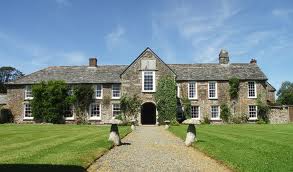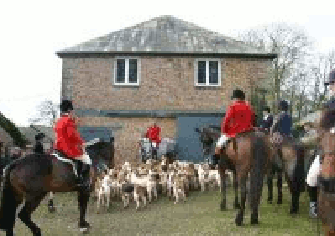THE SOUTH TETCOTT HUNT
The village of Tetcott lies six miles to the south of the North Devon market town of Holsworthy, near the meeting of the Tamar and Claw rivers in a rural location. Though the records are incomplete, the Tetcott Hunt certainly dates back to the middle of the 18th century (and quite possibly a lot earlier), and the game and hunting books have been kept meticulously over the years. In later years the parish was able to boast two packs - the Tetcott and South Tetcott Hunts.

The Tetcott Estate now consists of some 5,260 acres, mainly in a ring fence in the Devon parishes of Tetcott, Luffincott and Clawton, and contains some 4,720 acres of let farmland, the 20 acre park adjoining the Tudor Manor House, 14 separately let and 10 service cottages, and some 500 acres of woodland.
Country sports, and especially hunting, has dominated the area around Tetcott for many years – certainly since the eighteenth century – for in 1752 a ballad was penned to commemorate a day's riding with the hounds of the then Squire John Arscott. John Arscott, the father of the old Tetcott Hunt, was born around 1719 and lived all his 70 years at Tetcott with his beloved hounds kennelled nearby. Squire Arscott died in 1788 and, apparently, his successors hunted the same neighbourhood for many years afterwards.
In the late 1820s Parson Jack Russell and Mr Phillips of Landue paid occasional visits to the area until about the middle of the century, the country eventually relapsing into neglect.
paid occasional visits to the area until about the middle of the century, the country eventually relapsing into neglect.
Around 1860, Mr Vincent Calmady took the shooting of the Tetcott estate and about 1872 he collected a small pack of hounds to hunt the otter. Then in 1879 he turned his attention to the fox, and revived the old Tetcott country with the help of his first whip and kennel huntsman, Phil Back, who joined him in 1886. Mr Calmady’s very successful time at Tetcott produced some really good sport that lasted until 1896, when Mr Scott Browne took over the pack, calling it by his name and kennelling it on his private estate at Buckland Filleigh.
Then followed various adjustments of the country, with a separate pack (after 1906 known as the Tetcott) hunting the western side. Eventually the First World War caused Mr Scott Browne to give up his country and, in order to hunt the area left vacant, the then Tetcott hounds moved farther north, and the South Tetcott pack was formed to occupy Mr Calmady’s old kennels and to hunt the southern end of the country that presently stretches from the rugged Cornish coast at Crackington Haven to Hatherleigh in West Devon.